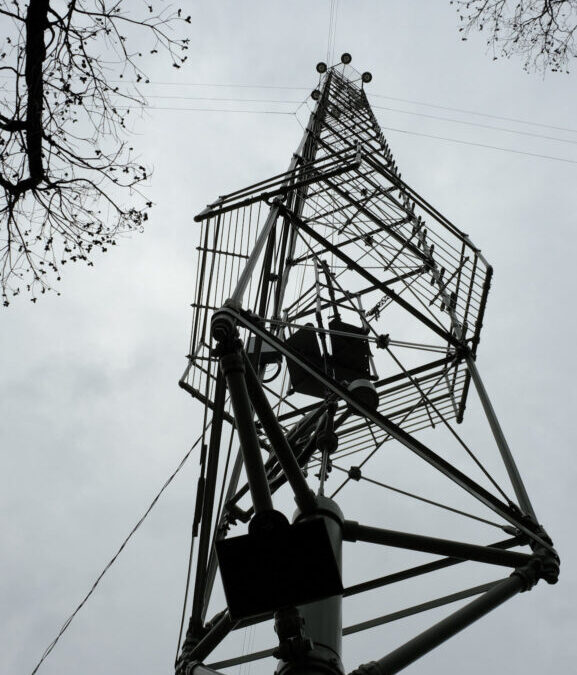The phrase “moontower” immediately brings “Dazed and Confused” to mind for many Austinites. It’s an invitation to “party at the moon tower,” as Ricardo Trevino put it.
Every summer, Trevino leads a group of bikers to do just that. In 2011, members of the local bike community began an annual 21-mile bike ride to all of Austin’s 17 moontowers. The ride is free and open to the public, attracting locals and visitors alike. In recent years, the event has seen between 150 and 200 participants. The cruise kicks off in the late evening of a new moon, the dimmest of the moon’s phases, to enjoy the lights and take a ride through Austin’s history.
Austin is the only place in the world that still has functioning light towers, affectionately termed moonlight towers or moontowers. However during the late 19th century, the moontowers lit up cities all over the world. The arc lamps, later replaced by LED bulbs, emitted light too bright to put at ground level, so they were placed within 165-foot wrought iron structures weighing 5,000 pounds. Between 1984 and 1985, 31 light towers were erected across Austin, 17 of which are still standing.
By the late 19th century, light towers were replaced by individual street lighting elsewhere in the world. Austin could not afford the update, and Austinite’s grew attached to the towers. Now, moontowers are part of the city’s rich culture.

Start at Pfluger Pedestrian Bridge
The ride begins at the Pfluger Pedestrian Bridge and makes a big loop around the heart of Austin. This meeting place is three miles away from Tom Muller Dam, a key location in the moontowers’ storied history.
Before the Tom Muller Dam, the site was home to the original Austin Dam, constructed from 1890 to 1893. The dam brought electricity to the city, powering electric street cars and the light towers. UT Austin Professor of History Bruce Hunt said this event helped Austinites feel like part of the modern world.
“(Austin) was a little town, like 15,000 people. Maybe it’s a state capital, but Texas before oil was not a wealthy state,” Hunt said. “But now they have electric lights, electric street cars. They’re on the go.”
In 1900 the Austin Dam collapsed resulting in direct fatalities and wiping out Austin’s power. Electricity was quickly restored by a steam-powered electric plant, however the event left Austin in debt. By the time other cities were replacing tower lights with smaller street lights, Austin could not afford to in part because of the dam’s collapse, Hunt said. Eventually, holding on to the towers became more than a financial decision.
“A lot of the city lighting engineers wanted to replace them by the 1950s and 60s,” Hund said. “By then, people liked them. They were nostalgic for them.”
Through Downtown
As riders make their way downtown, the sparkling city lights blur together. Austin’s present-day nightlife is in stark contrast to the blanket of darkness that once covered the city as the sun set every evening – something the moontowers made the first step in changing. The city hasn’t stayed stagnant and neither have the moontowers.
“You can trace how (the moontowers) were moved and how they really reflected changes in the city,” Hunt said. “For instance, there are very few downtown, because if you have tall buildings, it makes no sense to have a moonlight tower.”

First Stop Hyde Park – Moontower 8
Northbound, the riders say a quick hello to The University of Texas before reaching their first of two mid-ride rest breaks – the 41st and Speedway moontower. The Hyde Park moontower was the first moontower in Austin and now the farthest north.
Though presently a booming area, before electrification Hyde Park proved too far a walk from downtown, making it undesirable. Real estate developer Monroe Martin Shipe hoped to market Hyde park as a wealthy suburb and spearheaded building streetcar lines to the area and erecting the first moonlight to illuminate development.
“It was a spectacle,” Hunt said. “People came from all over to see the moonlight tower. That was (Shipe’s) way of promoting and selling land in Hyde Park.”
Second stop Travis Heights – Moontower 15
As riders meander southbound through East Central Austin and then back across the Colorado River to Travis Heights, they enjoy the night air. The mass of riders has thinned, as people drop off when the route nears their home neighborhood.
Many native Austinites have fond memories of the moontowers. The moonlight tower ride became an official event nearly 14 years ago, but Austinites have been biking to the moontowers for decades. Despite the full ride requiring several hours, it serves as a call back to youth.
“Back in the 90s, somebody used to stash beers at the moontowers, it was a lot longer ride because of that.” Trevino, who took over the role of moonlight night ride leader in 2017, said. “At each moontower, you’d have to go searching. Somebody either tied it up and it’s on top of the moon tower. You’d have to climb it to get it. Or, they’d leave clues, you know, as to where it possibly could be.”

End at the Zilker Christmas Tree – Moontower 17
The ride concludes at the moontower that doubles as the Zilker Christmas tree during the holiday season. According to restoration architect David Hoffman, the Zilker moontower was originally a 1967 replica tower that was later replaced by one of the original 31 moontowers in the 90s due to corrosion. When December hits, the Zilker moontower gets a makeover with the addition of 39 streamers each with 81 multi-colored bulbs.
“That was part of growing up (in Austin), to go and spin around under the Zilker Christmas tree, which was really a moonlight tower,” Hunt said. “That added another layer of appeal to the moonlight towers to people in Austin.”
The moontowers serve as a reminder of youth, history and culture. They represent the moment Austin came to life.
“Everybody today takes having electric power absolutely for granted,” Hunt said. “But it was brand new to people then. It changed their lives.”
This year’s ride is tentatively set for May 10. Learn more about the ride by following the Moonlight Tower Ride Facebook group or keeping up to date with Austin’s Bike Month events.
RELATED: The Ultimate Austin Bucket List: A Guide to the City’s Most Iconic Spots
The post Pedal Through History on This Nighttime Journey to All 17 of Austin’s Iconic Moontowers appeared first on Tribeza.

